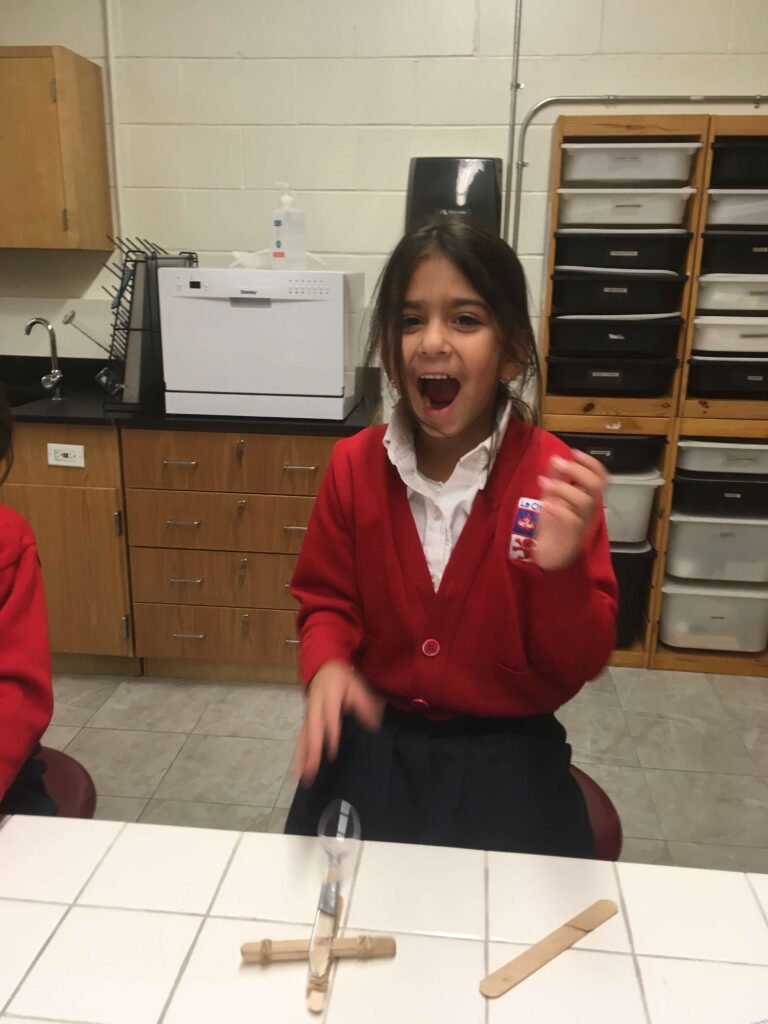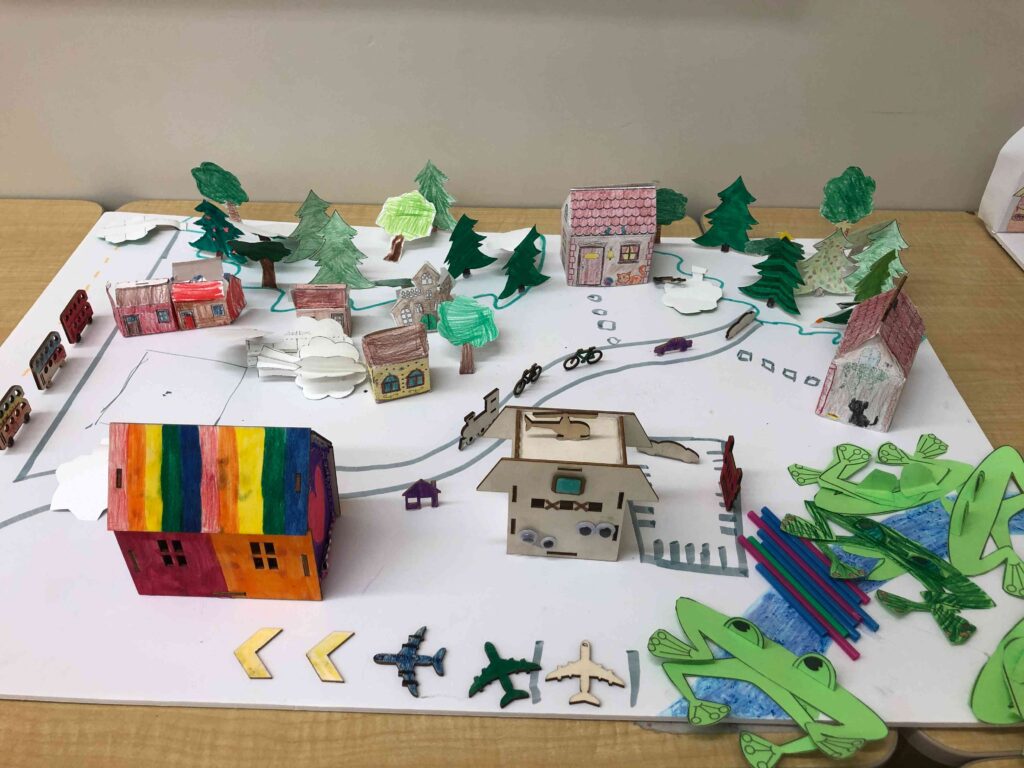Engineering projects come in all shapes and sizes! Our engineering themed workshops are packed with fun challenges, from building electric circuits to designing cool bridges and exploring flight. Kids dive into exciting activities that spark creativity and teamwork, all while learning the basics of engineering. Each workshop is a thrilling adventure that turns curious minds into young inventors.

Make 3 dimensional (3D) boxes using a 2 dimensional paper and a pencil drawing that you created yourself! Cubes, cones and other shapes… just with a stroke of a pencil!

Embark on a creative journey where we create their 2-dimensional drawings and transform them into 3-dimensional boxes using our own geometric drawings. From squares to cubes, curbes to cones and various other shapes, we will learn to visualize and construct complex forms with just a stroke of a pencil. This hands-on activity will not only hone our artistic skills but also deepen our understanding of geometry and spatial reasoning. Through this innovative approach, we’ll explore the intersection of art and mathematics, fostering creativity and critical thinking in equal measure.
Why use a helmet? What are the best materials to protect from a free fall? What are parachutes for? Let’s build and test the best defences and protections against a free fall in this experiment devoted to gravity.

Why use a helmet? What are the best materials to protect from a free fall? What are parachutes for? In this STEAM workshop, children design and test parachutes to protect a toy during a fall. By combining science, technology, engineering, art, and mathematics, they explore principles of aerodynamics, air resistance, and design. Through experimentation with various materials and configurations, they develop their understanding of motion physics and parachute design. This hands-on activity fosters creativity, problem-solving, and experiential learning.
Cannons and catapults are powerful and dangerous weapons based on the physical principle of “to every action, there is a reaction.” Let’s create mini-cannons and catapults and throw cannon… no; coton or paper balls!

We all know that catapults and cannons were powerful and destructive medieval weapons based on basic principles of physics. In this dynamic STEAM workshop, let’s dive into the construcion of a catapult and a cannon. By integrating science, technology, engineering, art, and mathematics, we’ll explore mechanics, energy transfer, and projectile motion. Experimenting with materials, adjusting designs, and analyzing results, we’ll gain hands-on experience in problem-solving and critical thinking. By the end of this activity, we’ll not only leave with new knowledge and engineering skills but also with our own creation!
I turn on the light, warm my snack, watch TV… Without electricity, all this would not be possible! But, how does electricity circulate? How do you “cut” the current? An electrifying experiment will help us solve these mysteries.

I turn on the light, heat up my snack, watch TV… Without electricity, it wouldn’t be easy. But how does electricity “flow”? How do we cut the power? An electrifying experiment will help unravel these mysteries! Children will dive into the fascinating world of electrical circuits by building their own lighting system. They will discover the concepts of conductors and insulators while assembling simple circuits. Using their newly acquired skills, they will also create a skill and dexterity game, adding a playful touch to their exploration of electricity. This workshop promises to ignite the curiosity of young inventive minds while developing their science skills and problem-solving abilities.
Who will build the highest, lightest, biggest most solid structure? With a little creativity, basic materials, and teamwork, we will build a table, a boat, a tower, shelves or something else… Whatever today’s challenge is, we are ready!

A typical STEM construction challenge engages participants in designing and building a structure using principles of science, technology, engineering, and mathematics. In our challenges, students are tasked with solving a problem or achieving a specific goal within given constraints. They begin by brainstorming ideas, then move on to planning and designing their structure using mathematical and scientific concepts. During the construction phase, they apply engineering principles to create a stable and functional design. Finally, they test their structure to assess its performance and make any necessary adjustments. This hands-on challenge promotes critical thinking, problem-solving, and teamwork skills while fostering creativity and innovation.
Melt chocolate without fire, without an oven or a heater… how is that possible? By building a solar oven, of course!
In this STEM workshop, kids embark on an exciting journey to harness the power of the sun by creating and testing their very own solar ovens. With simple items like cardboard, aluminum foil, and plastic wrap, they construct their solar ovens, learning about solar energy absorption and heat transfer along the way. Once built, they put their ovens to the test, experimenting with different food items to see how effectively their creations can cook using only the sun’s rays. This hands-on experience not only teaches them about renewable energy and sustainability but also sparks their curiosity and creativity in exploring scientific concepts.
A car is very common, but a car we built ourselves? That’s more unique! An engine, four wheels, our engineering talent, and voila, we have a car!

In this workshop, children engage in building an air-powered or electric car. They grasp the importance of an energy source to propel the vehicle, and the need for uniform wheels to reduce resistance and facilitate their creation’s movement. They also gain insight into the fascinating history of car invention. Using simple materials, they design and construct their own vehicle, understanding how energy is converted into motion and how aerodynamics aid in their car’s speed. This interactive experience fosters creativity and learning while providing a fun glimpse into automotive technology.
We have lots of articulations in our body; our elbows, knees, shoulders… Let’s build an articulated claw that can make our arm “longer”
How do you carry heavy weights without heavy machinery? Why did Archimedes say “Give me a lever long enough and a fulcrum on which to place it, and I shall move the world?” We will explain this world-old year old phenomena in an uplifting experiment.

Let’s uncover the ancient art of manipulating heavy weights without the aid of machines. By delving into the fundamental principles of physics, we’ll grasp why Archimedes uttered the famous phrase: “Give me a lever long enough and a fulcrum on which to place it, and I shall move the world.” Through hands-on demonstrations, we’ll witness how the clever use of levers and balance principles can effortlessly move massive objects or create a decorative mobile.
Where would you like to live? In a big city? A small village? In the countryside? By the sea? Here is your chance to create your own 3D city, with houses, buildings, streets and you can add the scenery that you want. But, let’s not get carried away; let’s start with one or two 3D houses and grow our space one house at a time!

What would be your ideal living place? In a bustling city? A picturesque village? Or perhaps in the countryside, by the water? Here’s your chance to design your own 3D city, complete with houses, skyscrapers, streets, and even the landscape of your dreams, using the principle of equivalence between 2D drawings and 3D shapes! But let’s not aim too big… let’s start with just one or two 3D houses, a street, and expand our city gradually!